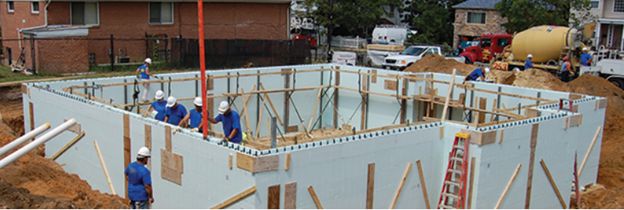Learning About Insulated Concrete Forms (ICF)
By Administrator
The idea of Insulated Concrete Forms (ICF) dates back from after World War II when blocks of treated wood fibers mixed with cement were used in Switzerland. At about 14 years old, the Canadian Jean-Louis Béliveau was intrigued by the deterioration of the family house he helped his father to build four years prior. In the late 70’s, Jean-Louis worked with the University of Iowa to design insulated concrete panels without thermal bridges. He designed and patented his first ICF prototype later in the 1980’s.
With the ability to be stacked like Legos and used at the same time as forms and permanent rigid insulation for concrete walls, ICF’s help contractors to build faster and more efficiently. Once the ICF is placed in the appropriate locations, concrete is directly poured into the hollow space between the ICF panels. When mounted correctly, ICF provide the insulation and air-sealing qualities of structural insulated panels. They can provide an R-value of 24 with thermal mass properties of up to R-50.

Ranging from 4-in to 12-in wide, ICF’s can be used in both residential and commercial foundation walls or upper walls. Manufacturers also provide a range of accessories (hangers, brackets, clip, straps, etc.) to accommodate proper installation for different applications of ICF.
Another interesting product offered by Nudura, one of the leading ICF manufacturers, is the Hydrofoam radiant heat insulation. It’s made of 2-1/2” thick, 4’x4’ boards easily installed with the ability to be interlocked on all four sides. Unlike traditional radiant heat insulation, Hydrofoam doesn’t require multiple steps to run radiant heat piping. Heating piping is installed in any direction into a 360o multi-directional friction fit anchor system. Providing R-10 of insulation value, this system increases installation speed, allowing to easily cut any angle or radius. With training from manufacturers and experience working with ICF, our team has the capability to incorporate this new building technology in your next project.
More Articles From...
| This Category | Architectural Design, Educational Training, Engineered Consultations, Residential Engineering, Structural Design, Structural Engineering |
| This Author | Administrator |
